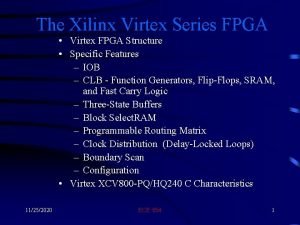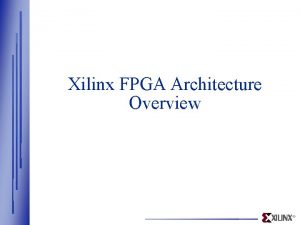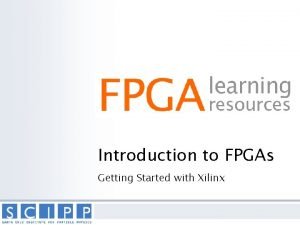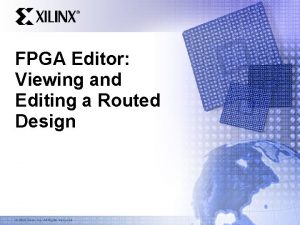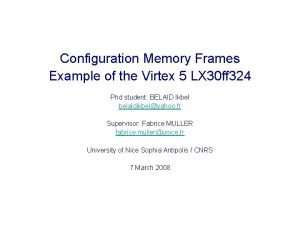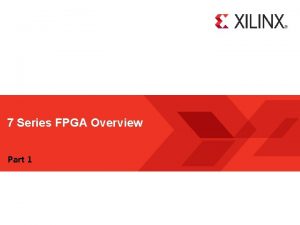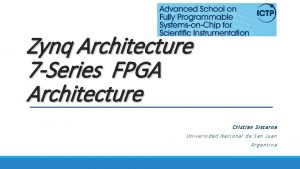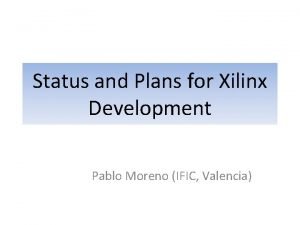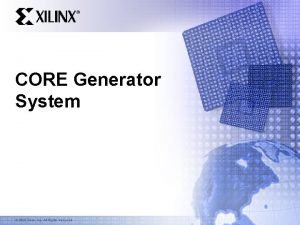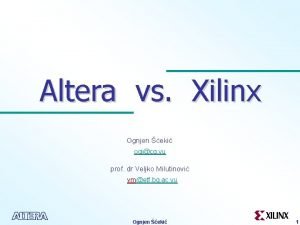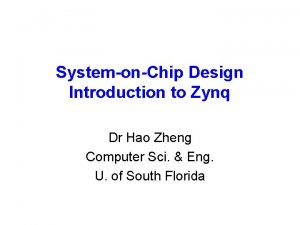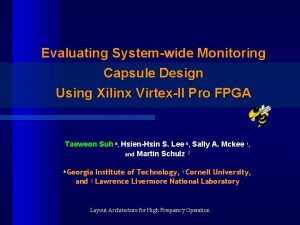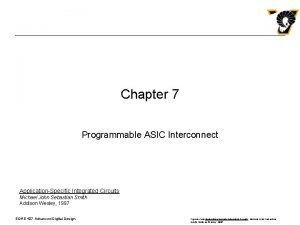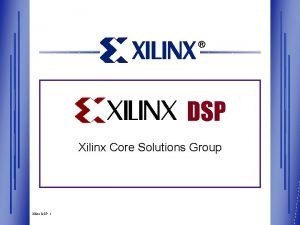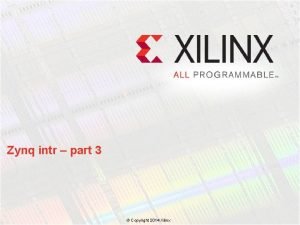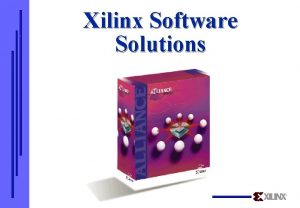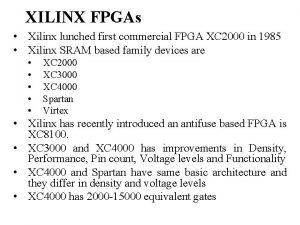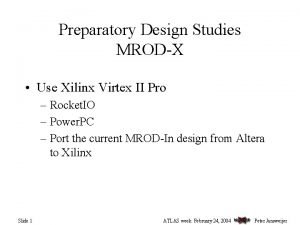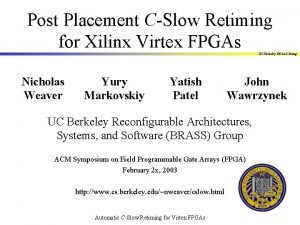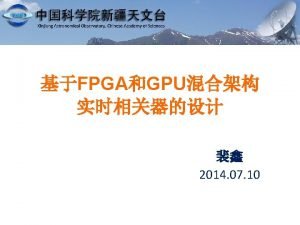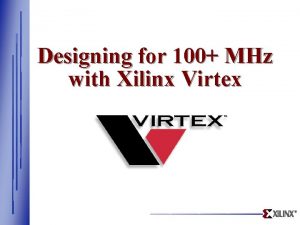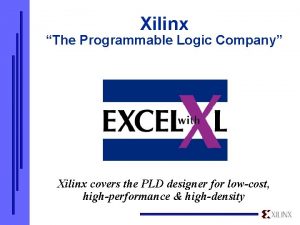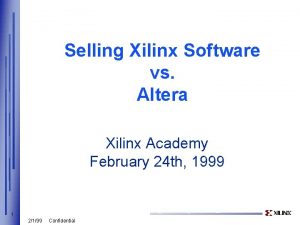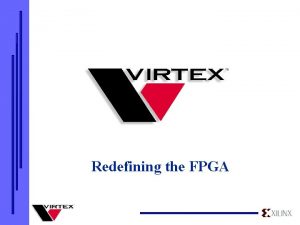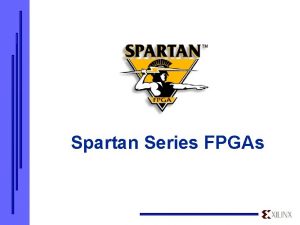The Xilinx Virtex Series FPGA Virtex FPGA Structure


































- Slides: 34

The Xilinx Virtex Series FPGA • Virtex FPGA Structure • Specific Features – IOB – CLB - Function Generators, Flip-Flops, SRAM, and Fast Carry Logic – Three-State Buffers – Block Select. RAM – Programmable Routing Matrix – Clock Distribution (Delay-Locked Loops) – Boundary Scan – Configuration • Virtex XCV 800 -PQ/HQ 240 C Characteristics 6/8/2021 ECE 554 1

Virtex FPGA Architecture • Primary Reference: – On-Line Xilinx Data Sheet DS 003 (v. 2. 5, April 2, 2001) - http: //www. xilinx. com/partinfo/ds 003. pdf • See Figure 1: Virtex Architecture Overview – – – – 6/8/2021 IOBs - Input/Output Blocks CLBs - Configurable Logic Blocks GRM - General Routing Matrix 3 -state buffers BRAMs - Block Select. RAM DLLs - Delay-Locked Loops Versa. Ring - I/O interface routing resources ECE 554 2

Figure 1 - Virtex Architecture Overview 6/8/2021 ECE 554 3

Virtex FPGA Architecture • Logic configured by values stored in SRAM cells – CLBs implement logic in SRAM-stored truth tables – CLBs use SRAM-controlled multiplexers – Routing uses “pass” transistors for making/breaking connections between wire segments • See Table 1: Virtex FPGA Family Members 6/8/2021 ECE 554 4

Table 1 – Virtex FPGA Family Members 6/8/2021 ECE 554 5

IOB - Input/Output Block • See Figure 2: Virtex Input/Output Block • Output Features – Optional data output D flip-flop with clock enable and shared asynchronous Set/Reset – Optional 3 -state control D flip-flop with clock enable and shared asynchronous Set/Reset – Three-state output buffer – Independent polarity controls on output buffer and control signals 6/8/2021 ECE 554 6

Figure 2: Virtex Input/Output Block 6/8/2021 ECE 554 7

IOB - Input/Output Block • Output Features (continued) – Electrostatic discharge (ESD) (protection) – Optional pull-up and pull-down resistors (note comments in documentation on state of pull-ups and pull-down during configuration) – Weak keeper circuit – Wide range of low-voltage signaling standards (See Table 3). – Strong current drive (24 ma source, 48 ma sink) – Drive strength and slew rate controls 6/8/2021 ECE 554 8

IOB - Input/Output Block • Input Features – Input Buffer – Wide range of low-voltage signaling standards – Programmable delay forcing pad-to-pad hold time to zero – Optional data D flip-flop with clock enable and shared Set/Reset – Optional pull-up and pull-down resistors (Same ones as for output use) 6/8/2021 ECE 554 9

CLB - Configurable Logic Block • See Figure 4: 2 -Slice Virtex CLB • Contains two logic cells • Each logic cell contains: – 2 Look-up tables (LUTs) – 2 D flip-flops/latches – Fast carry logic – Three-state drivers – SRAM control logic 6/8/2021 ECE 554 10

Figure 4: 2 -Slice Virtex CLB 6/8/2021 ECE 554 11

CLB - Configurable Logic Block • See Figure 5: Detailed View of Virtex Slice • Logic Function Implementation – 2 Function Generators - Each a 4 -input LUT implements any 4 -input function – F 5 multiplexer - combines two LUTs with select input implements any 5 -input function, 4 -to-1 mux, or selected functions of up to 9 inputs. – F 6 multiplexer - combines outputs of two F 5 multiplexer - implements any 6 -input function, 8 -to-1 mux, or selected functions of up to 19 inputs. – Four direct feedthrough paths - useful to facilitate routing by use of through-the-cell paths 6/8/2021 ECE 554 12

Figure 5: Detailed View of Virtex Slice 6/8/2021 ECE 554 13

CLB - Configurable Logic Block • Storage Elements – – 2 D flip-flops/latches Optionally included in cell output paths Shared clock enable Shared synchronous/asynchronous Set/Reset signals • SR - forces storage element into initialization state specified • BY - forces storage element into opposite state – All control signals independently invertible 6/8/2021 ECE 554 14

CLB - Configurable Logic Block • Fast Carry Logic (See Figure 5) – Two chains of two bits per CLB – AND gate, 0/1 Mux, CY Mux, EXOR – Manchester Carry Chain-Like • 3 -state Drivers (BUFT) - on-chip drivers with independent control (T and E) and input pins • Distributed LUT Select. RAMs - Per logic cell, one of: • • • 6/8/2021 Two 16 x 1 -bit synchronous RAM 16 x 2 -bit synchronous RAM 32 x 1 -bit synchronous RAM 16 x 1 dual-port synchronous RAM Two 16 -bit shift registers ECE 554 15

Block Select. RAM • Fully synchronous dual-ported 4096 -bit RAM – – Stores address, data and write-control signal on inputs Cannot change address, even for read without using clock For dual port use, interesting timing restrictions See App Note XAPP 130 http: //www. xilinx. com/xapp 130. pdf • Organized in vertical columns of blocks on left and right of CLB array • Block height is 4 CLBs => Number of block per column is (height of CLB of array)/4 • See Table 3: Virtex Block Select. RAM Amounts • See Figure 6: Dual-Port Block Select. RAM • Independent control signals for each port • See Table 4: Block Select. RAM Port Aspect Ratios • Ratios independently selectable 6/8/2021 ECE 554 16

Tables 3 & 4 and Figure 6 6/8/2021 ECE 554 17

Programmable Routing Matrix • Local Routing – See Figure 7: Virtex Local Routing – Interconnections among LUTs, flip-flops, and General Routing Matrix (GRM) – Internal CLB feedback paths that can chain LUTs together – Direct paths between horizontally-adjacent CLBs – Short connections with few “pass” transistors => low delay => high-speed connections 6/8/2021 ECE 554 18

Figure 7: Virtex Local Routing 6/8/2021 ECE 554 19

Programmable Routing Matrix • General Purpose Routing – Majority of interconnect resources – In horizontal and vertical routing channels associated with rows and columns of CLBs – GRM - Switch matrix through which horizontal and vertical routing resources connect and means by which CLBs access general purpose routing • 24 single-length lines between adjacent GRMs in 4 directions • 72 buffered hex lines route GRM signals to other GRMs 6 blocks away in 4 directions • 12 longlines are buffered bidirectional wires that distribute signals across the device – Vertical - span full device height – Horizontal - span full device width 6/8/2021 ECE 554 20

Programmable Routing Matrix • I/O Routing – Versa. Ring – Supports pin-swapping and pin-locking – Facilitates pin-out flexibility for concurrent connecting component design • Dedicated Routing – Four partitionable bus lines per CLB row driven by BUFTs (See Figure 8: BUFT Connections) – Two dedicated nets per CLB for vertical carry signals to adjacent cells 6/8/2021 ECE 554 21

Figure 8: BUFT Connections 6/8/2021 ECE 554 22

Programmable Routing Matrix • Global Routing – Distribute Clocks and other signals with high fanout – Primary Global Routing • Four dedicated global nets with dedicated input pins for clocks • Driven by global buffers – Secondary Global Routing • 24 backbone lines, 12 across top of chip and 12 across bottom of chip • From these, can distribute 12 unique signals/column via 12 longlines in column • Not restricted to routing only clock pins 6/8/2021 ECE 554 23

Clock Distribution • Via primary global routing resources • See Figure 9: Global Clock Distribution Network • Four global buffers – Two at top center – Two at bottom center • Four dedicated clock input pads • Input to global buffers from pads or from general purpose routing 6/8/2021 ECE 554 24

Figure 9: Global Clock Distribution Network 6/8/2021 ECE 554 25

Delay-Locked Loops (DLLs) • One associated with each clock buffer • Eliminate skew between clock input and internal clock-input pins within the device • Each can drive two global clock networks • Clock edges reach internal flip-flops 1 to 4 clock periods after they arrive at the input. • Provides control of multiple clock domains (See Tables 1 and Figures 4 & 7 for DLL app note XAPP 132) • Has minimum clock frequency restrictions! 6/8/2021 ECE 554 26

Table 1 and Figures 4 & 7 6/8/2021 ECE 554 27

Boundary Scan • • IEEE(ANSI) Standard 1149. 1 Provides Ability to Observe and Control I/Os Accessed Through a Standard Test Access Port (TAP) TAP Has Four Inputs (TCK, TMS, TDI) and One Output (TDO) • Additional Logic Includes Test Instruction Register, ID Register, two User Registers and a One Bit Bypass Register. • Uses: – – Test Interconnects between ICs on Boards Perform Tests on Internal Logic Initial Built-In Self-Test Logic Perform Sampling During Normal Operation • See Figure 10: Virtex Series Boundary Scan Logic 6/8/2021 ECE 554 28

Figure 10: Virtex Boundary Scan Logic 6/8/2021 ECE 554 29

Configuration - How Is It Implemented? • Implemented by loading configuration data into 2 D configuration SRAM • See Table 7: Configuration Modes – Mode selected by Mode Pins - Dedicated pins, M 0, M 1, and M 2 for configuration • See Table 11: Virtex Bit Stream Lengths 6/8/2021 ECE 554 30

Tables 7 & 11: Configuration Modes & Bit Stream Lengths 6/8/2021 ECE 554 31

Summary of XCV 800 Characteristics • • • 6/8/2021 Maximum Gate Count CLB Matrix Logic Cells Maximum IOBs Flip-Flop Count Block RAM Bits Horizontal TBUF Long Lines TBUFs per Long Line Program Data (bits) ECE 554 888, 439 56 x 84 21, 168 512 43, 872 114, 688 224 168 4, 715, 616 32

Summary of XCV 800 Characteristics (continued) • Interconnections – – – 6/8/2021 Single Length Hex Length Longlines Globals - Primary Globals - Secondary (Backbone) Carry Logic ECE 554 24 72 12 4 24 2 33

References • On-Line Xilinx Data Sheet DS 003 (v. 2. 5, April 2, 2001) – http: //www. xilinx. com/partinfo/ds 003. pdf • XAPP 130 Using the Virtex Block Select. RAM+ Features (v 1. 4) – http: //www. xilinx. com/xapp 130. pdf • XAPP 132 Using the Virtex Delay-Locked Loop (v 2. 6) – http: //www. xilinx. com/xapp 132. pdf 6/8/2021 ECE 554 34
 Tables 11 to 25
Tables 11 to 25 Xilinx fpga architecture
Xilinx fpga architecture Xilinx roadmap
Xilinx roadmap Getting started with xilinx fpga
Getting started with xilinx fpga Fpga editor
Fpga editor Fpga presentation
Fpga presentation Virtex parts
Virtex parts The virtex 5 fx130t has _____ clock regions
The virtex 5 fx130t has _____ clock regions Artix 7 architecture
Artix 7 architecture 7 series fpga architecture
7 series fpga architecture Xilinx donation program
Xilinx donation program Code vhdl
Code vhdl Xilinx synthesis tool
Xilinx synthesis tool Rocketgtp
Rocketgtp Xilinx power estimator
Xilinx power estimator Vivado core generator
Vivado core generator Altera vs xilinx
Altera vs xilinx Xilinx soc
Xilinx soc Xilinx
Xilinx Xilinx lca
Xilinx lca Verilog parameterized bit width
Verilog parameterized bit width Xilinx concat
Xilinx concat Paul hartke
Paul hartke Xilinx isp
Xilinx isp Xilinx clock divider
Xilinx clock divider Vörösházi zsolt
Vörösházi zsolt Maclaurin series vs taylor series
Maclaurin series vs taylor series Balmer series lyman series
Balmer series lyman series Serie de taylor
Serie de taylor Deret maclaurin
Deret maclaurin Ibm p series
Ibm p series Series series feedback amplifier
Series series feedback amplifier Series aiding and series opposing
Series aiding and series opposing Arithmetic series vs geometric series
Arithmetic series vs geometric series Hát kết hợp bộ gõ cơ thể
Hát kết hợp bộ gõ cơ thể
